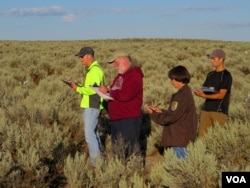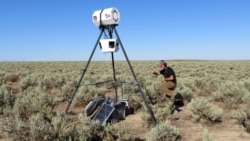How important is natural quiet? In southwestern Idaho, biologists are purposefully making a racket to find out.
An invisible road - heard but not seen, thanks to a half-kilometer long string of outdoor speakers - created the sonic illusion of cars racing through the Boise National Forest. The two year experiment demonstrated that road noise alone causes migratory birds to flee and fail to gain weight, according to Boise State University Professor Jesse Barber.
Now, in a continuing effort to discover how wildlife and humans respond to noise pollution, his research team has set up a phantom natural gas field.
"This study is replicating compressor station noise from natural gas extraction fields on a much larger scale than the phantom road," Barber explained. "We have six noise sites and six control sites."
The sound is an irritating reality in oil and gas basins throughout the American West. Barber wants to test the idea that as the soundscape gets louder, it's not just the wildlife that suffers. "That also feeds back on to how much people get out of that experience, how much they value it, and thus how willing they are to protect that same place."
Barber's research team will temporarily relocate to Northern California next year to survey visitors at Muir Woods National Monument and other parks about how they perceive noise.
Muir Woods is home to the park systems' first permanent quiet zone, at its Cathedral Grove. Once it was established, "Visitor sound level dropped as though half as many visitors were there," said Kurt Fristrup, branch chief for science and technology in the Natural Sounds and Night Skies Division of the park service.
He said Glacier National Park in Montana and Crater Lake National Park in Oregon are among the parks investigating "quieter pavement." Another strategy getting traction at some park units is to shift visitors from private cars onto shuttle buses during peak season. Congestion relief is main impetus behind that, but it has additional benefits. Fristrup said acoustic monitoring at Utah’s Zion National Park found the shuttles certainly leave a noise footprint, but their use reduces vehicle traffic so much that natural quiet noticeably increased.
And there is more. A new partnership between the park service and a nonprofit called Powering Imagination - headed by aviator Charles Lindbergh's grandson Erik Lindbergh - aims to develop quiet, electric aircraft that could someday greatly reduce the noise from air tours.
As the second and final field season at the "phantom gas field" winds down in southwestern Idaho, Barber and his research team avoid anointing any favorite solution. "There is a lot of basic [science] work yet to be done," Barber said. The eventual findings could point to the best way to lessen our noisy footprint in the world.








